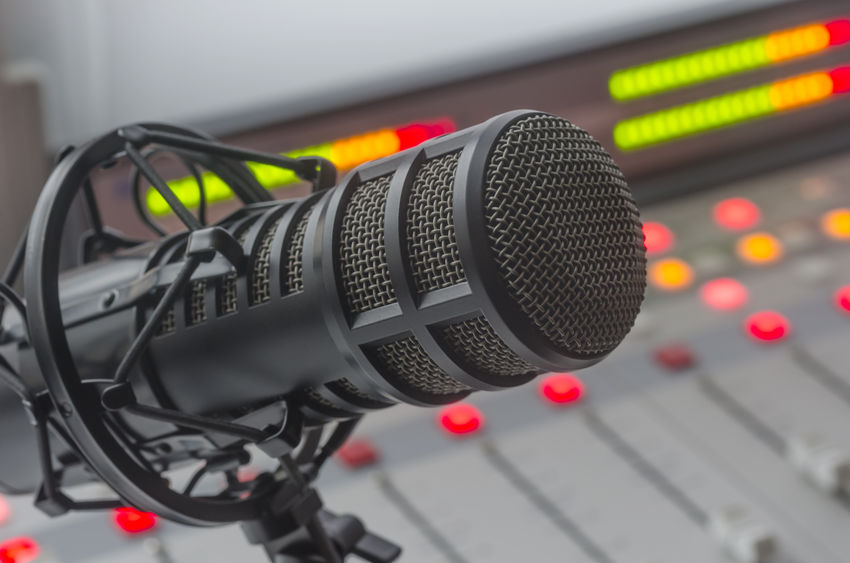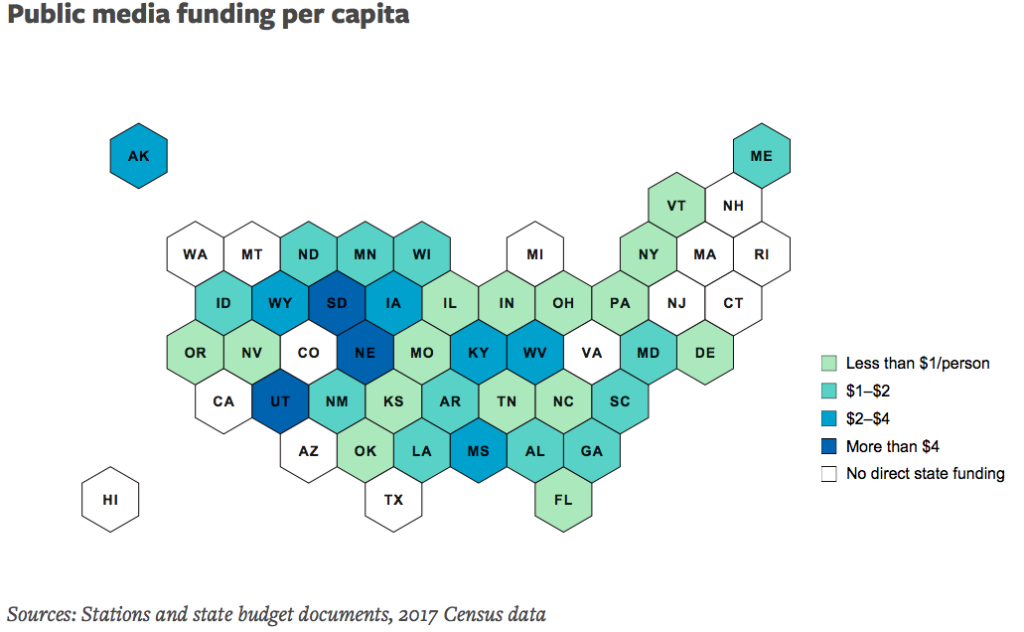AND A LOOK AT ALASKA ENERGY DESK’S REPORTING ON … ENERGY?
The line items for publicly funded radio and TV have been essentially spared in both House and Senate budgets.
The Senate made $146,000 in cuts to the current public broadcasting budget of about $3.5 million.
The House budget has no cuts at all to public broadcasting. Not a penny.
That means in Conference Committee this week, public broadcasting will likely lose no more than 4 percent of its budget — if that.
The sparing so far may be one reason public broadcasting reporters have been whistling by the graveyard, unwilling to report much on their own company’s budget cuts — there just haven’t been any to speak of.
Ferries, on the other hand, were given a $44 million haircut from the Senate, $10 million cut from the House. The Dunleavy Administration says the lack of State revenues requires a $97 million cut to ferries.
Education and the University system cuts are also dramatic. Public broadcasting reporters at least understand the optics of reveling in their own good fortune.
Of course, the budget has not yet hit the governor’s desk, and word has it, he’s got a red pen around there somewhere.
How funding works: The Alaska Public Broadcasting Commission, public radio and public TV are items in the Department of Administration budget. The commission distributes State funds to the 27 television, radio, and joint licensees around the state at a cost of more than $3-4 per Alaska citizen.
How much of public broadcasting does the State underwrite? The State currently funds 7 percent of AKPM’s annual budget, according to information on its website.
What the Dunleavy Administration is proposing: The Dunleavy budget zeroes out funding the $3.5 million that Gov. Walker put in his proposed budget in December. Gov. Michael Dunleavy has introduced legislation in the past to drastically reduce public funds for public broadcasting. Dunleavy has also proposed zeroing out the funds for the commission.
Why? The explanation given by the Dunleavy Administration was: “limited resources and the desire to focus on core services are primary drivers of reducing the state’s subsidy for public broadcasting.”
Where else do stations get their funds: Funding also comes from federal (through the Corporation for Public Broadcasting), local, tribal, and private entities. Pick. Click. Give. is one way Alaskans give, skimming from their Permanent Fund dividends.
Do all states fund their public broadcasting stations? No, there are 14 that do not provide funding.
What about emergency broadcasting? Proponents argue it’s an essential service for the emergency broadcasting “Alaska Emergency Alert System,” but in fact most Alaskans are now getting emergency messages from alternative providers. GCI has an emergency alert that goes to its 100,000 telephone users in the state, and others can or already are receiving emergency notifications on their cell phones from government and other media sources.
What if Dunleavy vetoes the spending for public broadcasting? The public is not likely to notice much change, since the State is funding a very small portion of the overall network’s budget.
MISSION DRIFT: THE ALASKA ENERGY DESK
Alaska Public Media has grown with the help of a major federal grant for the Alaska Energy Desk. In its request for funds, Alaska Public Media told the federal agency it was going to use the money to report on oil and gas issues and the high cost of energy in rural Alaska. It is paid for through a grant from the Corporation for Public Broadcasting.
In fact, much of its reporting has nothing to do with energy. In recent days, reporter Nat Herz filed a story on how the Dunleavy Administration hired a green, 25-year-old to do labor relations for the state, at a cost of $94,000 a year. In a previous story, Herz reported on political bloggers in the Capitol.
Other recent headlines from the Alaska Energy Desk show the project has little to do with energy, but is just a general reporting group for whatever it wants to focus on. One would expect some drift into climate change, and the conflicts between subsistence whaling and offshore oil exploration, but the reporting goes far afield:
“Marie Adams Carroll became a ‘folk hero’ fighting for Iñupiat whaling rights. Now she’s in the Alaska Women’s Hall of Fame”
“Senate passes budget that ignores most of Dunleavy’s cuts”
“An international airplane feud could crimp one of Alaska’s most lucrative fisheries”
“Sen. Murkowski asks for longer Pebble Mine comment period”
“Two tribes, Dunleavy at odds over tribal sovereignty”
“Caring for Alaska’s seniors during tense budget talks”
“As Capitol reporters dwindle, Alaska lawmakers grapple with rise of political blogs”
In fact, the argument can be made that Energy Desk is not doing energy reporting much at all, but political reporting, anti-Dunleavy Administration reporting, and never declaring a conflict of interest concerning the zeroing out of its own budget.
Reporter Nat Herz, once at the Anchorage Daily News, has simply transferred his Capitol beat to the Alaska Energy Desk, and continues as usual. Now, his stories are appearing in the Anchorage Daily News under the “Alaska Energy Desk” tagline.
In the 2019 budget summary for Gov. Bill Walker, public broadcasting proclaimed that in the 2018, “Alaska’s Energy Desk produced award winning coverage of energy issues. The unit produced hundreds of radio reports, as well as many news items for national broadcast, video productions and season two of the Midnight Oil podcast called, The Big Thaw, about climate change issues in Alaska. The project has added partners and is a collaboration of Alaska Public Media, KTOO Public Media, KUCB Unalaska, KBRW Barrow, the Fairbanks Daily News Miner and new this year, KYUK in Bethel.”
On Facebook, it’s also a news organization devoted just to energy and the environment:

And the official mission statement of the Alaska Energy Desk says it’s all energy, all the time:
Alaska’s Energy Desk is a collaboration between KTOO-FM in Juneau, Alaska Public Media in Anchorage, KUCB in Unalaska, Fairbanks Daily News-Miner in Fairbanks, KBRW in Utqiaġvik and KYUK in Bethel. Each week we produce in-depth coverage of energy issues in Alaska that air on local stations, the Alaska Public Radio Network and on national news programs. The desk also maintains an active social media presence including regularly publishing engaging videos. From the state budget to personal energy use, resource development to Arctic life, we cover how energy issues impact Alaskan lives and landscapes.
The oil and gas industries have shaped and reshaped Alaska. Everything from the state budget to our environmental protections and our way of life are tied to energy production. Through level-headed journalism, we explore the ways these issues are connected while we simultaneously untangle legal battles, analyze policy decisions and highlight industry practices that affect our communities.
CAN THIS ORGANIZATION SURVIVE WITHOUT STATE FUNDS?
A quick review of all the recent stories by the Energy Desk shows that Alaska Public Media and its satellite stations loosely interpret the uses for the funds received from the federal government for the six-reporter team. They’re reporting on whatever is most interesting to them, which often involves attacks on Republicans and the governor in particular.
The question for the Dunleavy Administration is: Can public broadcasting in Alaska survive without 7 percent of its overall budget?
The media group appears to already have found fungible, adaptive budget strategies that will allow it to continue without so much as a mic check.


“Can public broadcasting in Alaska survive without 7 percent of its overall budget?”
Only one way to find out…pull the plug on public money best spent elsewhere than for a left-wing tree house club…..I was frankly shocked after leaving AK to find out public broadcasting is shockingly OBJECTIVE in Oregon of all places and that Alaska’s is out of step with many of its contemporaries with failing to serve its populace…
Public broadcasting in Alaska had always been a tool of the Left. We all know that. I wouldn’t donate a dime to any of their fundraisers, and I dont want Dunleavy to donate any of Alaska’s money to public broadcasting. But if necessary, require equal time on all public stations in Alaska. Rush Limbaugh, Michael Savage, Joe Pags, Laura Ingraham, Sean Hannity, Canadian Mark Stein, Mark Levin. Watch the Liberals howl. DO NOT FUND!
You need to follow the money better. More state funds go to AKPM than what you report. For starters look at the UA BOR/UAF budget and inkind support-free to low rent etc.
Arguably AKPM deserves more state support, but any discussion of state support of AKPM should use real numbers.
APRN is a democratic propaganda machine. Let them figure out their own funding.
Put the money in ARCS as they come from satellite signals and every village can receive them.
Radio stations don’t reach all the Villages.
Careful; ARCS doesn’t deserve a pass. ARCS broadcasts mostly commercial TV – complete with advertisements – to remote communities 24/7. Here is the latest schedule. http://030c78c.netsolhost.com/images/May_12_-_18,_2019.pdf
Seems a waste when rural community teachers decry the fact that many students stagger into school, if at all, because they were up all night watching TV. More, the content is generally counter-cultural when compared to the stated values of native Alaskan communities: your parents and leaders are stupid, consumerism is good, lots of casual sex is cool, etc. Spending precious public money to advertise behaviors that increase human suffering and contribute to higher suicide rates? Then spending more money to try to un-do all that through other state and federal programs?
If you simply have to support the ATT satellite communications system, that money and the public broadcasting funds could instead be used to support better broadband connectivity for rural schools. More likely, the land-based GCI-owned fiber and microwave networks are carrying at least some of this traffic, anyway.
The “emergency” issue is a red herring in a modern small community in rural Alaska where folks generally look out for each other better than in downtown Anchorage.
Radio waves don’t come close to touching the amount of villages as ARCS. At least there’s a mixture of five networks.
Bethel, dillingham and Nome are hub communities big enough to support commercial radio. Problem is there isn’t”windows of opportunity” from the FCC for more stations. I’ve been trying to get Sen Sullivan to work with the feds to open the airwaves.
I love Rock and roll, trying to get KWHL to put a transmitter in communities.
Seems like the reporter exhibits a lot of energy for his cause, so I guess he feels his desk is an energy desk. And it is in Alaska, I guess.
As for public support of broadcasting, of course it is not necessary or appropriate. Ironically, I believe the Leftists would be better off without it. Public support is small. They will make up the gap and would no longer have to pretend to be impartial, which they are not.
Once upon time it was considered “educational television”. These days there’s no attempt at “education” – only indoctrination. If limo liberals want to keep it they should also pay for it.
They can’t cut the Propaganda Broadcasting System! It’s an essential government function!